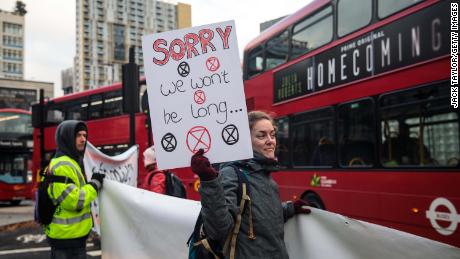Mark Lynas is a writer on climate change, and visiting fellow at the Alliance for Science at Cornell University. The opinions in this article belong to the author.
(CNN)To get the best view of current progress to tackle global warming, you need to climb a large volcano in Hawaii.
In the rarefied air atop the solidified lavas of Mauna Loa, more than 3,000 meters above the hubbub of modern civilization, sophisticated instruments hosted at the Mauna Loa Observatory take daily measurements of atmospheric CO2 concentrations.
Started in 1958 by Charles Keeling, the long-term output of these measurements is a graceful curve, which trends gradually upwards through recent decades. You can follow the Keeling Curve on Twitter -- earlier this year CO2 levels passed 410 parts per million, higher than at any time since the Pliocene, about three million years ago.
The Keeling Curve is a reality check, because it shows not the slightest downward blip despite increasingly intense international efforts to restrain greenhouse gas emissions. Remember the 1997 Kyoto Protocol? You won't see it on the Keeling Curve. Nor will you find any sign of the Copenhagen Accord of 2009, or even the much-heralded Paris Agreement of 2015.
In other words -- despite all the noise and fanfare, the sleepless nights and long days suffered by delegates at the annual UN Climate Change Conferences (the Conference of Parties, or COPs), all the pledges on solar targets and coal peaking dates -- humanity hasn't yet done enough to make a tangible difference to the relentless accumulation of carbon dioxide in our planet's atmosphere.
Addicted to fossil fuels
To find out the reason for this lack of progress, look no further than the International Energy Agency's annual reports. In 2000, the share of global primary energy supply coming from fossil fuels (coal, oil and gas) was 80%. In 2006 it was 81%. And in 2017 it was... drumroll... 81% again.
Yes, renewables -- led by wind and solar -- have grown enormously in recent years. But so has the global economy, and with it demand for energy to run our power stations, transport, industry and agriculture. In absolute terms clean energy can barely keep pace with growth, so the proportion of fossil fuels remains unchanged.
The Paris Agreement included a paper commitment to aim to restrain the global temperature rise to 1.5C above pre-industrial levels. We've hit 1 degree already, and unless greenhouse gas emissions are cut by half in the next 12 years -- an economic and political impossibility -- passing 1.5C is a virtual certainty.
What about the other commitments that governments signed up to in Paris? According to the latest analysis by the Climate Action Tracker, current government policies will lead to a global temperature increase of 3.4C in 2100 -- well above the committed target of 2C, and certainly enough to cause catastrophic impacts that could threaten the entire future of human civilization.
In Paris governments volunteered to cut their emissions, but add together these commitments and the resulting emissions path restrains the ultimate rise in global temperatures by a mere 0.2C, yielding a rise of 3.2C by 2100.
Anti-science denialism
It gets worse. The current political surge in right-wing populism, exemplified most by the election of President Trump -- who duly made a prime-time announcement that America would withdraw from the Paris Agreement -- endangers even the tiny progress that has so far been made.
Many of these populist movements make anti-science denialism an article of faith, with climate change action the most high-profile casualty. Australia's right-wing government has hinted it might follow Trump's example in ditching Paris, while president elect Jair Bolsonaro in Brazil has indicated he will redouble the destruction of the Amazon rainforest, where the pace of deforestation has already increased.
Where public pressure to enforce reductions in carbon emissions shows any sign of succeeding, fossil fuels companies pour millions into efforts to squash it. For example BP pumped around $12 million into the successful effort to block a moderate carbon tax in Washington state. Overall, fossil fuels companies outspend environmental groups by a margin of 10 to one.
And the greens themselves have scored some notable own goals. Germany's push to eliminate nuclear power has led to a renewed dependence on coal, and the bulldozing of ancient forests due to the resulting expansion of open-cast coal mining. Everywhere around the world that nuclear plants have been closed, they have been replaced by fossil fuels, worsening our climate emergency.
Recognizing this, the US environmental group the Union of Concerned Scientists recently broke ranks with the wider environmental movement in a new report calling for nuclear stations threatened with closure to remain open so as not to increase power sector carbon emissions. In Taiwan grassroots climate activists wearing polar bear masks won a referendum overturning the previous nuclear-exit policy.
The fight has barely begun
In the UK a new climate action group, Extinction Rebellion, burst onto the scene over the last month with daring actions causing chaos in the center of London. Their message came through loud and clear -- that if climate catastrophe is to be avoided, we will have to do more than issue polite but unenforceable pledges at annual UN conferences.
The COP is important, but what happens out on the streets in the real world is more so. You can see a long distance from the top of that Hawaiian volcano, and the figures don't lie: CO2 is building up irrevocably with each year of delay. Despite decades of COPs, the fight to save the Earth's climate from collapse has still barely begun.









